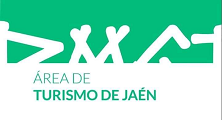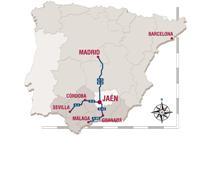Origins of San Lucas Fair
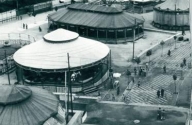
Origins of San Lucas Fair
Saint Lucas’s Fair is an autumn festival. Of all the fairs in Andalusia and Spain, it is the last festival held each year and is very nationally successful. We can say that Jaen’s Fair is one of the most important due to its bullfighting tradition.
Since the 80's, it has been mistakenly thought that Jaen’s fair was created by Castilla’s Constable, Mr Miguel Lucas de Iranzo and was to be celebrated at the same time as his saint’s day. This is one main belief about Jaen’s Fair, which is strongly engrained in Jaen's people, but we will discover that the San Lucas origins are quite different.
Origins: August Virgin Fair.
Jaen’s Fair was first celebrated around the 15th of August, which is Nuestra Señora de la Asunción’s day. It was established by prince Enrique de Trastamara’s privilege. He was the son of Juan II of Castilla and he was to be crowned the future king, Enrique IV. The Fair was increased by 5 more days in 1453 by petition of the City Council. This was decided due to the vast number of people that went to Jaen to venerate the relic of our Lord’s Holy Face, which was visible to the public in the Cathedral’s balcony.
Out of all of the religious celebrations, the August festival had an important economic aim. The prince’s privilege established an important cattle fair, which housed all of the little fairs and markets that were celebrated in the past in different parts of the city. Other activities were also allowed at the Fair, such as the sale of fruits, cereals, handmade esparto and ceramic tools or clothes, among others.
The Council, which had a huge economic influence until the middle of the 19th century, sponsored the development of these festivities and always tried to make them popular by improving their brightness and originality. This was because the Cathedral’s temple was under the devotion of Asuncion’s Virgin.
The fair was located in San Francisco Square, Campanas, Turroneria and Alamo Streets. After some time, it changed its location and was situated in Carrera, Saint Agustin, Mercado, Ejido and Eras of Belen Streets.
One important element of the fair was bullfighting events. Between the 15th and 18th centuries, bullfighting took place in Santa Maria Square, bull cages were located in Obispo Street and also in Mercado (market) square. In 1842, the City Council promoted the construction of a bullring in the outskirts of Puerta del Angel using stones from the old Capuchino’s Monastery that had been demolished. Alameda’s bullring was inaugurated at the August Fair of 1847 and was used for more than a century, until its demolition in 1960. After that, the current square was built.
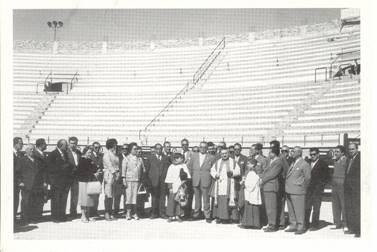
Blessing of the fairground "La Alameda". Year 1960.
Different recreational activities, which have changed throughout the years, completed the fair’s cultural offerings. One of the most important was the Municipal Music Band, which held musical performances to entertain people during events, such as bullfights, “verbenas”, etc. Large dance events also took place in casinos during the second half of 19th and the first half of the 20th century. Carousels, “Tio Vivos” and other children’s attractions were also very popular.
In the 30’s of the last century, Jaén’s August Fair started to decline in popularity and was finally removed in the Civil War years.Although it was reinstated, it never achieved the same popularity as it had in the past and was reduced to a simple feast in Arrabalejo’s Quarter.
San Lucas Fair.
Constable’s chronicle tells the story of how Don Miguel Lucas of Iranzo celebrated his Saint’s day. It was essentially a religious celebration. On the Eve of the Fair, people sang traditional songs in the main church and also enjoyed local foods.
In the morning of Day 18, the Constable and his court went to the main church procession where a chanting mass took place in San Lucas’s chapel. After that, there was a solemn mass in the main altar, which was attended by all of the city lords. When the mass finished they ate together and played popular games, such as “cañas game”. The Constable celebrated his family’s Patron Saint, Saint Lucas, on the18th of October.
In 1805, a major smallpox epidemic took place, so the August fair could not be celebrated and the City Council postponed it to the 18th of October, which was the same day as the small cattle fair.From 1914, when the Independence War finished, San Lucas’s Fair increased the number of people and livestock that attended the celebration.
From 1914, when the Independence War finished, San Lucas’s Fair increased the number of people and livestock that attended the celebration. This helped to increase the Fair’s popularity, but still it was a lower status fair.
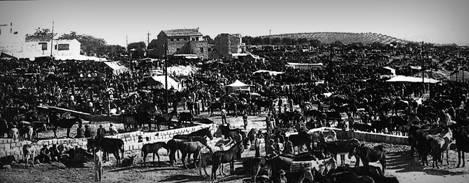
Cattle fair at the beginning of the 20th Century
In 1883, the Royal Friends of the Economical Society of the country launched a proposal to celebrate
The proposal was highly accepted in the city, so in 1883 San Lucas fair became the main fair of Jaén. August’s fair remained as a cattle fair until the middle of 20th Century and even had some memorable moments at the beginning of that century. Finally, it was removed and the fair of Capilla’s Virgin, which was originally a simpler quarter feast, became the second biggest fair in the city.
Originally, the fair was celebrated along the main squares and streets of the city, especially in Santa Maria, San Francisco and Dean Mazas (now Constitution) Squares.
The fair was also celebrated in inhabited open land spaces of the city, in places such as Arrabalejo, Victoria’s Park (now Concordia), Arquitecto Berges Street etc. The cattle fairs of San Lucas were situated in the outskirts of the historic quarter (Ejido de Belen, Loma del Royo, El Recinto, Peñamefecit, etc) so, animals did not cause discomfort or annoy neighbours of the historical quarter.
An important event in the history of the San Lucas Fair was the invention of the electric light in 1902. The fair was then illuminated by electric arcs. This year was the first time that people enjoyed parades of giants and big-heads in order to commemorate Alfonso the Thirteenth’s 18th birthday.
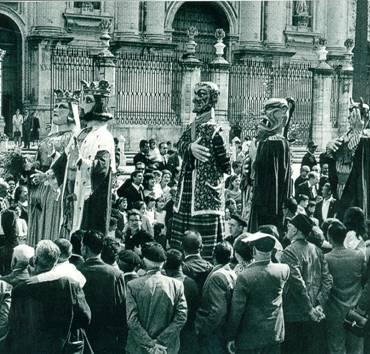
"Giants and big-heads". Middle of the 2oth Century.
The San Lucas Fair achieved national prestige in a short period of time, maybe because it was the last cattle fair celebrated in Andalusia, and because its bullfighting was very well renowned.
Important developments took place in 1942, for instance, activities, such as equine competitions, floral games, concerts by popular bands, theatre, regional folk dance recitals, craftsmanship, paintings and sculpture exhibitions, among others. Other attractions, such as “Jaen Lizard”, were included in Jaén’s Fair in 1944. Jaen’s Fair gained strength gradually, little by little, consolidating itself as one of the most important fairs in Spain.
Modern Fair.
Until 1954, Jaén did not have a fixed location to celebrate the fair with control and comfort. Fair project was carried out by Enrique de Bonilla y Mir. He held the fair in “Salobreja” (land devoted to agriculture) between “La Alameda” and Granada´s Road. The area was dedicated to Felipe Arche Hermosa who was
The Urban Development Overall Plan of 1952 established the location of the fairground in“La Salobreja” as the culmination of the plan of the construction of a big axis, the extension of “La Carrera” (Bernabe Soriano Street) that crosses San Ildefonso Quarter leading to the fair ground.
A big square joined the extension of “La Carrera” Street with Felipe Arche fairground. Its square led to the fair through a monumental staircase flanked by two big twin towers with high flags. After crossing the staircase, the area was divided into platforms with access via the main street which was adorned with trees. This main street access ran along the fair area leading to the soccer field (that was also intended to be constructed). The fairground included two communication roads for the attraction’s vehicles and also for loading and unloading of goods. The area was encircled by a circumvallation area to ensure efficient traffic flow.
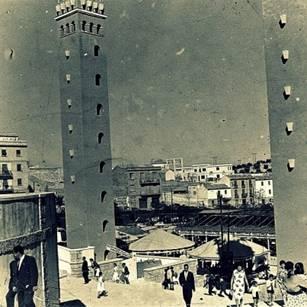
"Twin Towers" in Felipe Arche Fairground. Middle of the 20th Century.
This project implies that Alameda’s Park became the most important park in Jaén because it had direct access to the fair and to the above mentioned extension of “Alameda” Street. The park was also quite near to the bullfight ground. After the demolition of the old house of Arrastradero Street, the park was enlarged and decorated with gardens and trees as well as sport facilities.
Three large fairground booths were set up. The most important one was The Constable Booth, located at the corner of Granada’s Road where the fair’s shows took place. This fair booth had beautiful views to the fair’s lightings. The other fair booths were called Lizard and three Morillas. The fair was connected directly to Granada’s road, Cross avenue and San Jeronimo’s Portillo where new fair booths were located.
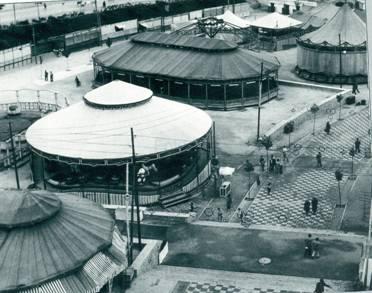
Central promenade and attractions in Felipe Arche's Fairground. Middle of the 20th Century.
At the beginning of the 90’s of the 20th century, the fairground was relocated because the former area became too small. The former Felipe Arche fairground was closed and replaced by a park. The San Lucas Fair had no fixed place until the construction of the new area eight years later. It was celebrated in an empty, open field of “Las Lagunillas” or in empty, open areas of the current Boulevard Quarter which had no adequate facilities.
Finally, in 1998 the fairground “La Vestida” was settled in a large area between Granada’s road, Ronda Sur and La Guardia’s road. The new area was divided into a system of platforms connected by staircases. To access the three former platforms you had to descend down an avenue. The fourth platform was located in the north side of the area annexed to an industrial building used as municipal fair facilities. Here, there were concerts, food tastings, children’s activities, etc. At the end of the avenue there was a large, empty space where the fair attractions and fair team caravans were located.
In 2002, the area was refurbished. It was asphalted because it was formerly made with Albero's sand. The industrial building was abandoned and a new one was built on the right side of the central fair booths, which became the municipal one, also used as circus facilities. The fair area was also renamed “Alfonso Sánchez Herrera's Fairground”.
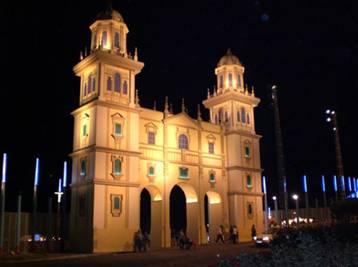
Main entrance of Alcalde Alfonso Sánchez Herrera's Fairground, imitating
the façade of Jaén's Cathedral. Year 2006.
In 2009, another renovation took place. The fairground was enlarged reaching a capacity of 100 fairground booths, distributed not in platforms, as in the past, but unified in the low area of the fairground.
By the main access of Granada’s road, where the traditional lighting façade is located we can reach the fair’s attractions and the area where the fair booths were located. They were placed in a huge area, which was divided into horse and carriage parades. The fair booths’ area allows the set up of 100 fair booths of approximately 150 square metres as well as the municipal fair facilities called “Jaen’s Arena area”. We can also find a large parking area, including a closed place for security, another big parking area for caravans and an empty area for young people’s outdoors meetings.

Horse parade at the current fairground
Nowadays, San Lucas fair retains traditional elements, such as a fair opening speech, the fair’s parade procession, bullfights, municipal music band concerts, little theatres, artist shows and cultural events, among others. The so-called “Daytime Fair” is very important in the historical quarter. It includes an exhibition of the traditional “chilindrinas” and they decorate the taverns with garlands and lanterns. Taverns and pubs create a very pleasant, charming and festive outdoor atmosphere, enjoyable for people from Jaen and all over the world.
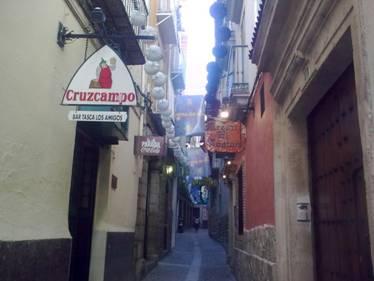
Bernardo López Street. Day Fair
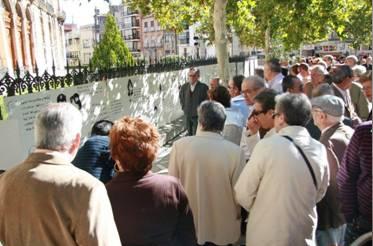
Exhibitions of “chilindrinas” in the gate of the Provincial Council.
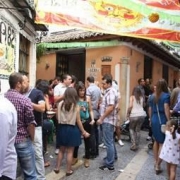
Day-fair in the historical quarter
Bibliography:
ORTEGA Y SAGRISTA, R. (2006): “Las ferias de Jaén”, en Senda de los Huertos 63-64, págs. 59-65.
ORTEGA Y SAGRISTA, R. (1996): “La feria de 1847”, en Senda de los Huertos 43-44, págs. 63-65.
ORTEGA Y SAGRISTA, R. (1993): “La feria del Condestable” en Senda de los Huertos 29, págs. 73-77.
CUEVAS MATA, J. (2012): “El ferial Felipe Arche”, en Senda de los Huertos 69-70, págs. 7-9.
LÓPEZ PÉREZ, M. (1992): “Feria tenemos”, en Las cartas a Don Rafael. Ayuntamiento de Jaén. Servicio de Publicaciones, Jaén, págs. 29-31.
